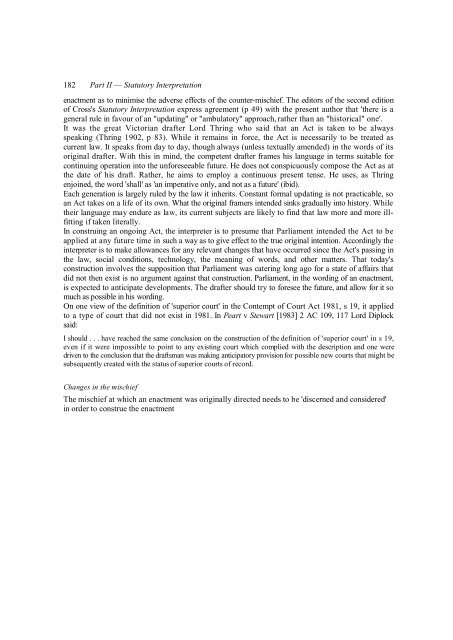Statutory Interpretation The Technique of Statutory ... - Francis Bennion
Statutory Interpretation The Technique of Statutory ... - Francis Bennion
Statutory Interpretation The Technique of Statutory ... - Francis Bennion
Create successful ePaper yourself
Turn your PDF publications into a flip-book with our unique Google optimized e-Paper software.
182 Part II — <strong>Statutory</strong> <strong>Interpretation</strong><br />
enactment as to minimise the adverse effects <strong>of</strong> the counter-mischief. <strong>The</strong> editors <strong>of</strong> the second edition<br />
<strong>of</strong> Cross's <strong>Statutory</strong> <strong>Interpretation</strong> express agreement (p 49) with the present author that 'there is a<br />
general rule in favour <strong>of</strong> an "updating" or "ambulatory" approach, rather than an "historical" one'.<br />
It was the great Victorian drafter Lord Thring who said that an Act is taken to be always<br />
speaking (Thring 1902, p 83). While it remains in force, the Act is necessarily to be treated as<br />
current law. It speaks from day to day, though always (unless textually amended) in the words <strong>of</strong> its<br />
original drafter. With this in mind, the competent drafter frames his language in terms suitable for<br />
continuing operation into the unforeseeable future. He does not conspicuously compose the Act as at<br />
the date <strong>of</strong> his draft. Rather, he aims to employ a continuous present tense. He uses, as Thring<br />
enjoined, the word 'shall' as 'an imperative only, and not as a future' (ibid).<br />
Each generation is largely ruled by the law it inherits. Constant formal updating is not practicable, so<br />
an Act takes on a life <strong>of</strong> its own. What the original framers intended sinks gradually into history. While<br />
their language may endure as law, its current subjects are likely to find that law more and more illfitting<br />
if taken literally.<br />
In construing an ongoing Act, the interpreter is to presume that Parliament intended the Act to be<br />
applied at any future time in such a way as to give effect to the true original intention. Accordingly the<br />
interpreter is to make allowances for any relevant changes that have occurred since the Act's passing in<br />
the law, social conditions, technology, the meaning <strong>of</strong> words, and other matters. That today's<br />
construction involves the supposition that Parliament was catering long ago for a state <strong>of</strong> affairs that<br />
did not then exist is no argument against that construction. Parliament, in the wording <strong>of</strong> an enactment,<br />
is expected to anticipate developments. <strong>The</strong> drafter should try to foresee the future, and allow for it so<br />
much as possible in his wording.<br />
On one view <strong>of</strong> the definition <strong>of</strong> 'superior court' in the Contempt <strong>of</strong> Court Act 1981, s 19, it applied<br />
to a type <strong>of</strong> court that did not exist in 1981. In Peart v Stewart [1983] 2 AC 109, 117 Lord Diplock<br />
said:<br />
I should . . . have reached the same conclusion on the construction <strong>of</strong> the definition <strong>of</strong> 'superior court' in s 19,<br />
even if it were impossible to point to any existing court which complied with the description and one were<br />
driven to the conclusion that the draftsman was making anticipatory provision for possible new courts that might be<br />
subsequently created with the status <strong>of</strong> superior courts <strong>of</strong> record.<br />
Changes in the mischief<br />
<strong>The</strong> mischief at which an enactment was originally directed needs to be 'discerned and considered'<br />
in order to construe the enactment

















